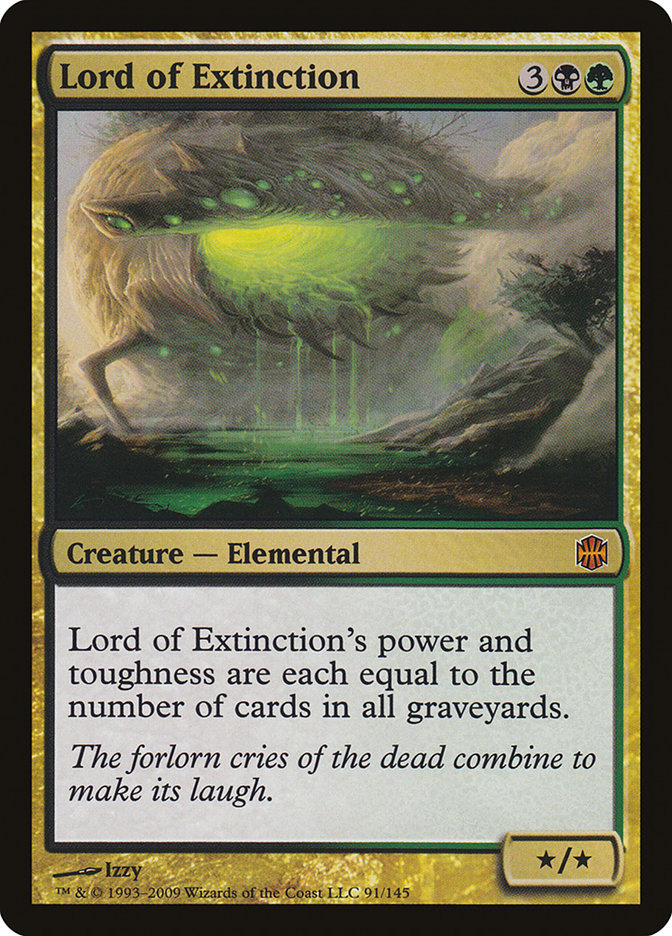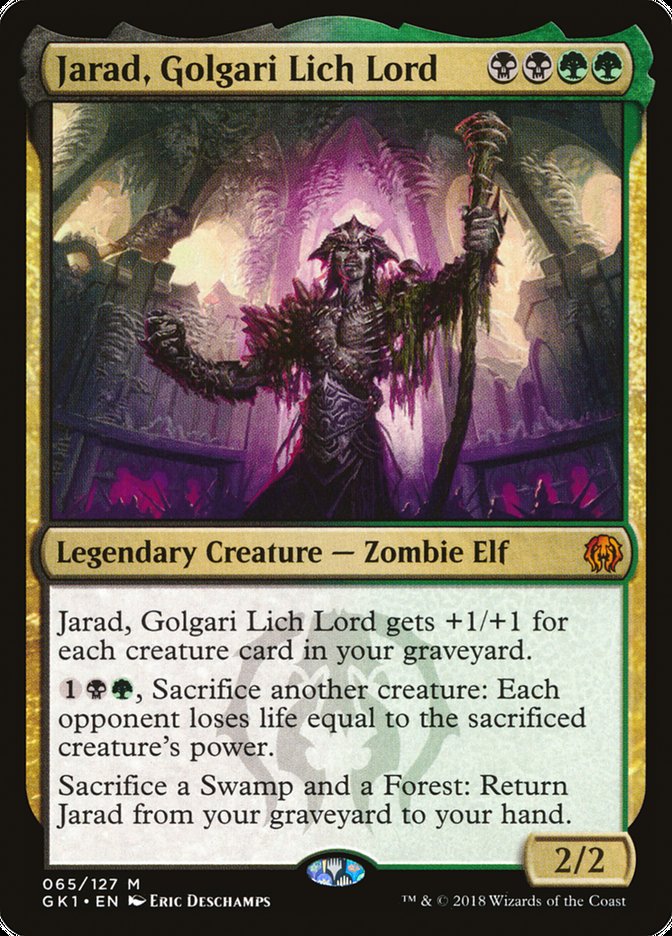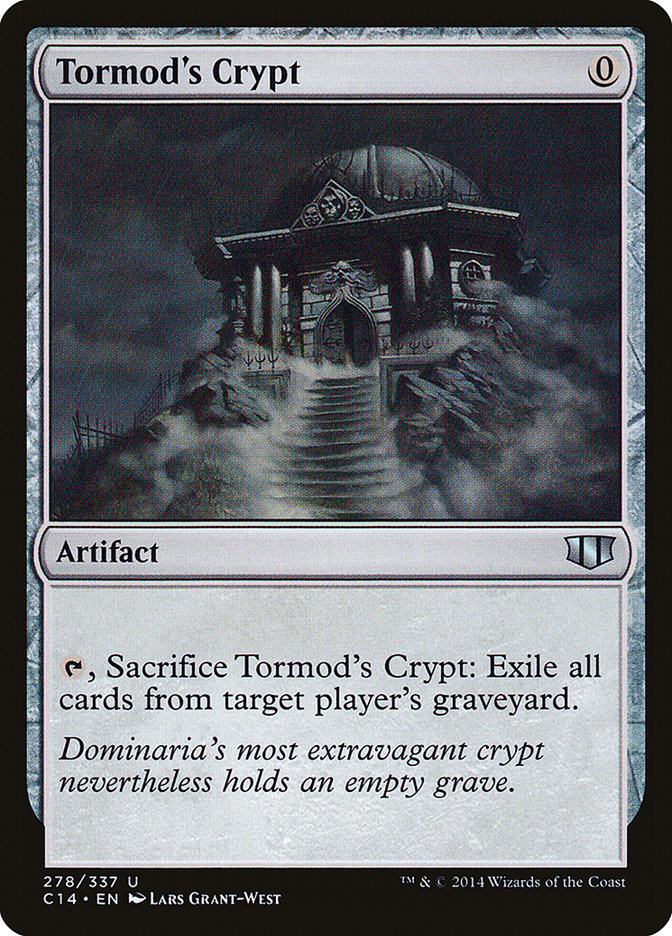With Halloween week here, it seems only appropriate that we build a deck with things that writhe and slither along on the ground. It just so happens that Izoni, Thousand-Eyed won the “which Guilds of Ravnica guild leader should I build a deck with?” poll, so it was a nice convergence.
I’m back to regular content creation now that surgery is in the rear-view mirror. For those of you who aren’t aware, I had a cancer recurrence, this time with a spot roughly the size of a lime appearing on my liver. The good news is that they were able to take out the whole thing with clean margins and saw no other evidence of masses, while taking only about 15% of my liver with it (they had predicted about 25%). I’m recovering way faster than they had expected; just two weeks out of surgery, I’m off painkillers and surprisingly mobile. I won’t be lifting anything heavy for a few months, but otherwise, the prognosis looks great. Hopefully this is last time you hear about it until I tell you I’m in complete remission.
Izoni was one of the Guilds of Ravnica cards which had initially piqued my interest, both as a potential commander and as 1 of 99. It’s the right time to explore it leading a team, so that’s the direction I headed. There was some thought to building an Insect tribal deck, but I liked the possibilities of going with other types of bugs as well, as it offered more flexibility. My primary thought about Izoni is that it’s rather narrowly focused. Unless you just want to use it as a sacrifice outlet, which might be a reasonable usage, we’ll need to make sure there are creatures in the graveyard. Izoni isn’t likely to kill anyone with commander damage, so we’ll have to use its abilities in the fashion it was designed for. As you’ll see, that’s exactly where we’re headed. Here’s the list:
Creatures (38)
- 1 Hermit Druid
- 1 Symbiotic Wurm
- 1 Yavimaya Elder
- 1 Living Hive
- 1 Nantuko Vigilante
- 1 Nantuko Husk
- 1 Saber Ants
- 1 Carrion Beetles
- 1 Millikin
- 1 Nullmage Advocate
- 1 Golgari Grave-Troll
- 1 Grave-Shell Scarab
- 1 Stinkweed Imp
- 1 Endrek Sahr, Master Breeder
- 1 Creakwood Liege
- 1 Lord of Extinction
- 1 Ant Queen
- 1 Scute Mob
- 1 Necrotic Ooze
- 1 Hornet Queen
- 1 Kessig Cagebreakers
- 1 Splinterfright
- 1 Vorapede
- 1 Jarad, Golgari Lich Lord
- 1 Giant Adephage
- 1 Nyx Weaver
- 1 The Gitrog Monster
- 1 Ishkanah, Grafwidow
- 1 Bontu the Glorified
- 1 Decimator Beetle
- 1 World Shaper
- 1 Stitcher's Supplier
- 1 Crash of Rhino Beetles
- 1 Ravenous Slime
- 1 Underrealm Lich
- 1 Glowspore Shaman
- 1 Kraul Foragers
- 1 Impervious Greatwurm
Planeswalkers (1)
Lands (37)
- 1 Strip Mine
- 11 Forest
- 9 Swamp
- 1 Temple of the False God
- 1 Phyrexian Tower
- 1 Miren, the Moaning Well
- 1 Golgari Rot Farm
- 1 Overgrown Tomb
- 1 Swarmyard
- 1 Terramorphic Expanse
- 1 Dakmor Salvage
- 1 Dryad Arbor
- 1 Twilight Mire
- 1 Verdant Catacombs
- 1 Bojuka Bog
- 1 Evolving Wilds
- 1 Command Tower
- 1 Woodland Cemetery
- 1 Grim Backwoods
Spells (23)
- 1 Overrun
- 1 Kodama's Reach
- 1 Decree of Pain
- 1 Mesmeric Orb
- 1 Thran Tome
- 1 Survival of the Fittest
- 1 Greater Good
- 1 Phyrexian Altar
- 1 Life from the Loam
- 1 Eldrazi Monument
- 1 Cultivate
- 1 Overwhelming Stampede
- 1 Triumph of the Hordes
- 1 Codex Shredder
- 1 Deadbridge Chant
- 1 Dictate of Erebos
- 1 Bitter Revelation
- 1 See the Unwritten
- 1 Commander's Sphere
- 1 Arachnogenesis
- 1 Zendikar Resurgent
- 1 Crawling Sensation
- 1 Journey to Eternity

Why Play It?
The primary reason to play this deck is that you really like what Izoni does. Two pretty cool abilities give you the opportunity to do some fun things. If casting creatures, drawing cards, and going wide is your thing, then this deck is right up your alley.
You’ll Like This Deck If…
We all know that when someone sits at a Commander table with a dredge deck, everyone else rolls their eyes, even if the dredge player makes their best effort to play as quickly as possible. You’ll enjoy this deck if you like dredge stylistically, but don’t necessarily want to be the person who eats up all the play time at the table sifting through your library and graveyard again and again and again.
Since the deck contains Survival of the Fittest, I would advise studying the list well enough so that you always know what you’re going to go get instead of being a tourist looking through your own library. The primary reason that Survival of the Fittest is there is to get more (and sometimes specific) creatures into the graveyard, as opposed to the normal idea of getting the optimal creature into your hand.
If you’re fond of making a bunch of creatures and then going wide with Overrun and its friends, this is a deck for you. It’s one of the few in which I’m okay with including a card like Triumph of the Hordes. The deck is somewhat low-powered, so giving it one of those outside-the-box kill possibilities seems fine.
I see the deck as a change from at least my own habit of focusing a deck on big, splashy things and instead looking toward less-used strategies.
You Won’t Like This Deck If…
You likely won’t be happy with this deck if you’re a fully committed dredge player or hoping to become one. It has dredge cards, but the mechanic is only part of what’s going on here. I wouldn’t even call it a sub-theme, but an enabler.
If you’re not fond of casting creatures, you’ll probably want to try something different. With 39 of them counting the commander, you will be casting them nearly every turn.
If you want an infinite combo, you won’t find one here. There are some big, splashy, killing things, like sacrificing Lord of Extinction to Jarad, Golgari Lich Lord, but those kinds of things are few and far between.
If you like circumventing casting costs (cards like Lurking Predators or Mind’s Dilation), this one isn’t for you. The idea is that the casting costs are low and the mana curve is tight, so you don’t need to cheat in the super-expensive stuff, since there isn’t much.
You won’t like this deck if you’re Bennie Smith, since it’s green and doesn’t have Grothama, All-Devouring.
What Does It Do?
Izoni’s Creepy Crawlies casts creatures that make other creatures which will then swarm your opponents. Sometimes, it’s just by having a raw number of them. Other times, it’s getting boosted by Overrun or Overwheming Stampede and going to town. It’s not likely to do that particularly early, but could certainly be lethal to someone by Turn 7 or so with even a reasonable draw.
What Doesn’t It Do?
The biggest thing the deck doesn’t do is provide battlefield control. There’s not much at all. There’s some creature control with Dictate of Erebos, especially given the number of creatures we’ll create, but other than that, we don’t have much to say about other players’ permanents. Nullmage Advocate and Nantuko Vigilante provide a little help with artifacts and enchantments and there’s one Strip Mine for a problematic land, but you’ll be able to use Life from the Loam in order to do that a little more if need be.
It also doesn’t fly. That led me to think about some cards like Silklash Spider, but in the end I decided that we’d just do our thing and not worry about the skies.
How Does It Lose?
Without much control or targeted destruction, the deck loses when it gets outclassed in the creature department and doesn’t have its one Fog effect, Arachnogenesis, or one of its few battlefield sweepers.
It doesn’t gain much life (although the commander will get you some), so you won’t be able to absorb particularly large hits.
You’ve been warned.
The deck will roll over to effective graveyard hate. There aren’t too many ways to prevent this for graveyard-committed decks; you just have to be aware there are there some times when you’re simply going to get wrecked by a well-timed Bojuka Bog or Rest in Peace. It happens. Take your beatings, shuffle up, and hit the run-backs.
The deck can suffer if someone else is playing a serious control deck that makes difficult keeping creatures alive. Eldrazi Monument is there in order to give you the upper hand against the Wrath-happy people and you should always be able to create enough creatures to keep it around. Consider especially using tokens created by Endrek Sahr, Master Breeder to feed to Eldrazi Monument, since that will keep him around longer. Still, you want creatures in the graveyard, so battlefield wipes might not be the worst thing for you.
Discussion of a Few Card Choices
Creakwood Liege: I can’t count the number of times that I’ve put Gleancrawler on a decklist while meaning Creakwood Liege. Got it right this time.
Endrek Sahr, Master Breeder: A card I’ve featured before, the low mana cost of most of the cards in the deck ensure that you won’t cast yourself into killing Endrek Sahr. The tokens are there to be used to fuel Izoni’s ability and a host of other sacrifice outlets. They’re usually the first ones that should go, unless there’s a nontoken creature you specifically want in the graveyard.
Hermit Druid: One of the cards that would probably get the heave-ho if we were designing the banned list to be targeted at competitive play, Hermit Druid is eminently fair in a deck that runs twenty basic lands. In fact, it’s pretty much decent value and not much else. When it’s built around with zero basics, it’s a different story.
Kessig Cagebreakers: While the Wolves it creates aren’t creepy or crawly, enough of them can be deadly, warranting its inclusion.
Millikin: A card from the long past that those of us who love graveyard decks always think about.
Phyrexian Altar: There was room for either this or Altar of Dementia, and it feels like the mana is a little more important than the option to mill opponents.
Ravenous Slime: Controlling other graveyards passively is always good news. The only potential downside is getting this thing Cloned, which would then be bad for our side.
Thran Tome: I always like to look for at least one old, somewhat forgotten card to include in decks. Thran Tome does what this deck wants to do at a reasonable cost.
World Shaper: Attacking with it once is enough, but there should be enough open paths to set several battles out of it before it gets killed. I considered Bow of Nylea as an addendum to World Shaper, but there didn’t seem to be room.
A Few Cards That Aren’t There
Blood Artist: I confess that it would be a fine card in this deck, but I’m just tired of playing with it. It’s so good at what it does, it’s become almost an auto-include in all black decks, and sometimes we just want to break habits that we’ve gotten into. If “optimization” is your thing, it’s a card that you’ll want to include.
The rest of the common dredge suite: Again, it’s not a dedicated dredge deck.
Dawn of the Dead: Especially with the sacrifice outlets, Dawn of the Dead could end up being a real beating. I would consider it if there were more cards in the deck with good enters-the-battlefield triggers.
Gaea’s Cradle: Although the deck makes lots of creatures, it doesn’t then use them to fuel huge things like a giant Genesis Wave. It doesn’t feel like it’s worth the investment to acquire one in order to not do much.
Oversold Cemetery / Palace Siege: Another choice that you might consider if you want a strongly optimized deck. There will always be enough cards in your graveyard to choose something cool to return and you’re only costing yourself one Insect when you cast Izoni. Perfectly worthwhile choice.
Vanquisher’s Banner: A recent favorite card of mine, but the deck moved away from being strongly tribal, making the Banner worth less. Its removal led me to Zendikar Resurgent, which isn’t all bad.
Question of the Week
This week’s question is one I’ve distilled from a recent post on the official forums.
What kind of secondary market factors influence your decision to ban or unban cards?
The short answer is none. That doesn’t mean we’re insensitive to what unbanning or banning a card could do to secondary market prices; it’s just that we don’t let it become a factor in our discussions, in part because there are lots of uncontrollable factors in market forces. Big dollar cards like Library of Alexandria are pretty unlikely to be unbanned because there’s a good reason they’re on the list in the first place. I imagine that if we were to ever actually consider unbanning cards that were banned under Perceived Barrier to Entry, we might want to have a lengthier discussion than we would otherwise.
Because we have insider knowledge, we also avoid the appearance of impropriety as well as actual propriety (something that may seem a little old-fashioned in 21st-century America). Scott has it easy, since he can’t legally sell cards because he’s a Wizards of the Coast employee. It also becomes doubly important to me as a member of the SCG writing staff. All of us want to make sure that integrity is the first thing you think about when it comes to the Rules Committee, so we generally don’t engage in buying, selling, or trading anytime near Banned List update times. I’m still sitting on a pile of foil Primeval Titans because I didn’t want to send any signals. When we unbanned Protean Hulk, I picked up a few copies—but only after the announcement had gone live. That’s simply how we do things on the RC.
Check out our comprehensive Deck List Database for lists of all my decks:
SIGNATURE DECKS
Purple Hippos and Maro Sorcerers; Kresh Into the Red Zone; Halloween with Karador; Dreaming of Intet; You Did This to Yourself.
THE CHROMATIC PROJECT
Mono-Color
Heliod, God of Enchantments; Thassa, God of Merfolk; Erebos and the Halls Of The Dead; Forge of Purphoros; Nylea of the Woodland Realm; Karn Evil No. 9.
Guilds
Lavinia Blinks; Obzedat, Ghost Killer; Aurelia Goes to War; Trostani and Her Angels; Lazav, Shapeshifting Mastermind; Zegana and a Dice Bag; Rakdos Reimagined; Glissa, Glissa; Ruric Thar and His Beastly Fight Club; Gisa and Geralf Together Forever.
Shards and Wedges
Adun’s Toolbox; Angry, Angry Dinos; Animar’s Swarm; Borrowing Stuff at Cutlass Point; Ikra and Kydele; Karrthus, Who Rains Fire From The Sky; Demons of Kaalia; Merieke’s Esper Dragons; Nath of the Value Leaf; Queen Marchesa, Long May She Reign; Queen Marchesa’s Knights; Rith’s Tokens; The Mill-Meoplasm; The Altar of Thraximundar; The Threat of Yasova; Zombies of Tresserhorn.
Four-Color
Yidris: Money for Nothing, Cards for Free; Saskia Unyielding; Breya Reshaped; Yidris Rotisserie Draft Deck.
Five-Color
Partners
Tana and Kydele; Kynaios and Tiro; Ikra and Kydele.
THE DO-OVER PROJECT
Adun Oakenshield Do-Over; Animar Do-Over; Glissa Do-Over; Karador Do-Over; Karador Version 3; Karrthus Do-Over; Kresh Do-Over; Steam-Powered Merieke Do-Over; Lord of Tresserhorn Do-Over; Mimeoplasm Do-Over; Phelddagrif Do-Over; Rith Do-Over; Ruhan Do-Over.
If you’d like to follow the adventures of my Monday Night RPG group (in a campaign that’s been alive since 1987) which is just beginning the saga The Lost Cities of Nevinor, ask for an invitation to the Facebook group “Sheldon Menery’s Monday Night Gamers.”




